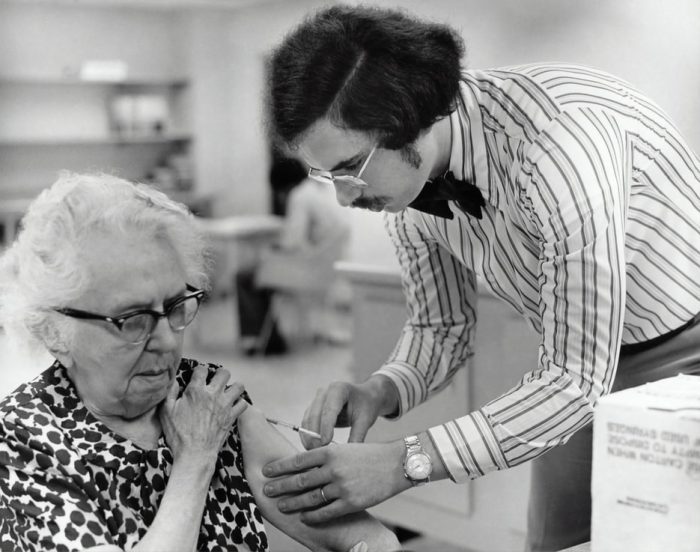For the past nine and a half months, I have been a virus fugitive.
I’ve been running, hiding, and doing my best to elude my enemy so I could continue to work, care for the sick, raise my kids, and have a healthy existence.
Sometimes, I suspect, I escaped by just a sliver of a second, a fraction of time delaying an encounter, so as not to infect me, and I’m not even sure how or why I escaped.
However, this day is Redemption Friday, the day bequeathing me with my first dose of active immunity via the Pfizer vaccine. And Friday happens to be my favorite day.
Arriving early is not usual for me. But this day, I have. Who wouldn’t? I’ve waited for this since March 2020, maybe even before. That means I’ve waited for approximately 292 days…but who, really, is counting?
A nurse greets each of us to check us in, ensuring that we do, indeed, have an invitation.
Name. Birthdate. Proof of identity. All good to go. She points me to table five, where a woman with salt-and-pepper hair greets me. She dons goggles and a surgical mask, and her crinkly eyes smile at me from behind wire-rimmed glasses. I think her name is Charlene, although this detail does not stick in my memory. I walk toward her, thinking about this long-awaited moment.
Char is sweet and ready for me, telling me that I am only her second patient of the day. She, too, percolates with happiness to finally arrive here, at this moment, when a vaccine is available. She admits that she has not yet received her own as she will be in the second tier of phase 1a distribution, and we are not there yet.
The shot itself is quite anticlimactic, although for one moment, I become overwhelmed by the prior nine months—a brief tsunami of emotion overtakes me and I cry tears of hope that the end is in sight. I feel gratitude to be on the receiving end of the sharp syringe. The jab doesn’t even register, and before I know it, I am asked to sit still for 15 minutes for observation following my inoculation.
Before my appointment, I had considered, for less than a fraction of a second, whether I ought to get this vaccine, or continue to try to avoid becoming infected with SARS-CoV-2. Basically, my thoughts convalesced into whether I would rather get the mRNA, lipids, chemical compounds with big names, and sucrose within the vaccine that, though approved for emergency use by the FDA, has not been technically approved in the usual fashion. Or, whether I would want to continue as I have been, and maybe eventually get the virus.
My thoughts jump again, wandering back in history, and I think about diseases people have had to endure during the history of infections on this earth.
Eerily, echoes of “Ring around the Rosie, a pocket full of posey, ashes, ashes, we all fall down!” resounds in the confines of my overactive brain, and in real time, I glance at the recently vaccinated man to my left who is absorbed in his iPhone. My brain returns to the past and I think about the Black Death, way back to just over 650 years ago, when an ill-fated ship pulled in to a harbor in Sicily, bringing its dead, its sick, and its black rat fleas, infected with Yersinia Pestis, the bacteria that caused the bubonic plague.
Unbeknownst to the rest of Europe, this ship reservoir was about to seed and spread one of the deadliest of infections to its people, wiping out some 50 million—percentage wise, almost half the population. Paranoia spread as quickly as disease, and border controls were placed at city gates, harbors, and mountain passes. Individuals were issued health passports complete with requisite information of name, address, and status of health. Spy networks signaled when a plague had erupted in a certain region—a rudimentary form of news fueled both true and false information.
The people living then had no recourse, and likely felt as though they were sitting ducks, waiting for infection to strike. They had no hope of treatment, of cure, and often, they were abandoned by those who normally cared for the sick. Their doctors left them, fleeing for their lives. There was no glimmer of hope through a vaccination, and I am sure dread and fear was part of every waking moment of their days.
My thoughts revert to the present and I note that I am so grateful to be in the here and now, and not back then, because I get to receive a vaccine and avoid illness, alleviating the angst I feel in the day-to-day care-taking of others who have become afflicted with the virus. My heart is full. I am grateful.
Uneventfully, I leave the room when my 15-minute observation period ends. It is quiet in the hallway, and 15 more frontline healthcare workers line up six feet apart to receive their vaccine. They check in just like I did, and I see one who is crying openly, exclaiming that her grandmother died of the disease and she wished she’d had the chance to have her grandmother vaccinated. I pause and take that in for a second. Grateful for the hope that a vaccine brings, I continue to my car, and on with my day.
Author’s note: This piece was written as an invitation to others to consider receiving the SARS-CoV-2 vaccine.
If you are considering not getting this vaccine, please know while I do believe you have every right to choose, I wish you would first consider the following:
1. Given that the virus is so widespread, and there is absolutely no global chance of containment, we either will live with continued worldwide infection of this contagious virus and accept a death rate of one to three percent—according to Johns Hopkins data—of those infected. We may or may not reach eventual burnout of the virus, due to lack of viable hosts, also called “herd immunity.” The cost of this is almost an immeasurable amount of life lost prematurely, which might sound sterile until one of those lives is someone you love.
2. On March 25, 2020, Ed Yong wrote an article in The Atlantic entitled, “How the Pandemic Will End.” In it, he describes what he calls a “whack a mole” approach to ending the pandemic. This means we stamp out outbreaks by mass testing and adherence to the stay at home when sick recommendation, and mass vaccination of all persons as quickly as possible, which means we may have to consider the greater good over our own desire to let others be the “guinea pigs” of the vaccine.
Historically people willingly accepted vaccines, because illness was so catastrophic, especially in our younger population (which thankfully is usually not the case with COVID-19).
Take polio, for example. Similar to COVID-19, polio is a mild illness in about 98 percent of people who get it. However, about one to two percent of people get paralyzed from the virus, and some die. Initially, it was called infantile paralysis, because the infliction of the young was so devastating. Polio, however, did not only infect just the young, and hence its more common name.
Anyway, scientists invented a vaccine for polio. The initial vaccine was a live virus, altered enough so it would usually not create disease. Please pause for effect here. It would usually not create disease. That means that sometimes, it did cause disease, and people accepted this as an alternative to the chance that they would get the disease. In other words, people would rather take a vaccine that conferred immunity, with the rare (one in 2.4 million) chance that they would actually contract the disease. But those odds were better than a 1 in 100 chance of getting paralyzed if you got the disease. From 1963 until 2000 people were offered this oral polio vaccine, and then in 2000, the only form of polio vaccine offered in the United States was an inactive injectable form that can never cause polio.
In contrast, SAR-CoV-2 vaccine is not live—it cannot actually cause COVID-19. However, it may have side effects, like any foreign protein that enters our bodies. Similar to an insect sting or a food ingestion, SARS-CoV-2 is an engineered protein that looks like the spike, or crown, part of the virus. It isn’t even a real virus. Additionally, phase three trials on tens of thousands of people have occurred, and the most common side effects are mild. On rare occasions, a person may have a treatable allergic reaction called anaphylaxis. The only contraindication is having an allergic reaction to the actual vaccine, and given it is brand new, likely almost no one has had this reaction. Even people with allergies.
3. Time is of the essence. We have no idea how long we have immunity from infection, and rarely, we are seeing reinfection. Plus, we are seeing viral mutation that thankfully seems to be covered by our current vaccine. Right now, we have access to two, maybe three vaccines that have been proven safe and effective. No, they are not fun. But they are safe, and anything you are reading that tells you otherwise is fake news. Take my educated word on this. Further, I wonder, will it always continue to work? We do not know this, and I wonder if we really want to gamble on figuring this out. By way of vaccination, I believe the sooner we can eliminate viable viral hosts (us), the sooner we can be done with this pandemic.
These are hard times. There is no doubt about it.
They are fueled by fear, and fear fuels inability to fully reason. But with a very reasonably safe solution on the horizon, we can finally surface and grab some air. An end is in sight, but we likely can only make progress by working together. In the words of Henry Ford, “Coming together is the beginning. Keeping together is progress. Working together is success.”
Please, everyone, if for nothing other than the greater good, consider getting your vaccine.











Read 0 comments and reply